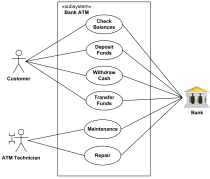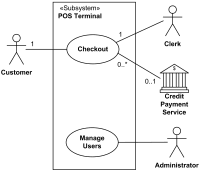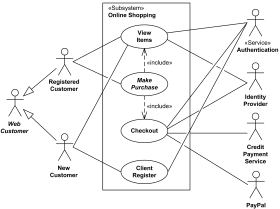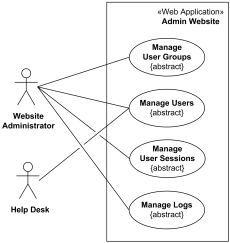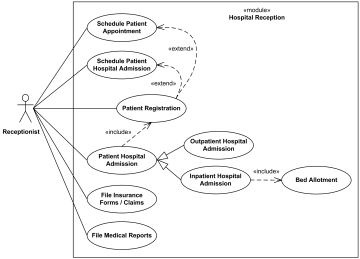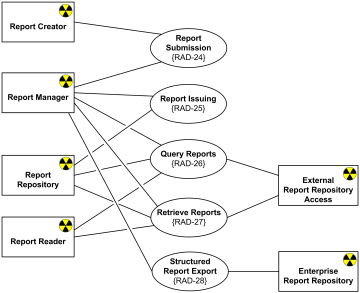UML Use Case Diagram Examples
Here we provide some examples of UML use case diagrams.
Examples of business use case diagrams
Purpose: An example of a business use case diagram for airport check-in and security screening.
Summary: Business use cases are Individual Check-In, Group Check-In (for groups of tourists), Security Screening, etc. - representing business functions or processes taking place in an airport and serving needs of passengers.
Purpose: Two alternative examples of business use case diagram for a Restaurant - external and internal business views of a restaurant.
Summary: Several business actors having some needs and goals as related to the restaurant and business use cases expressing expectations of the actors from the business.
Examples of system use case diagrams
Purpose: Show that ticket vending machine allows commuters to buy tickets.
Summary: The ultimate goal of a Commuter in relation to our ticket vending machine is to buy a ticket. We have a single Purchase Ticket use case, as this vending machine is not providing any other services. Ticket vending machine is a subject of the example use case diagram. Commuter and Bank are our actors, both participating in the Purchase Ticket use case.
Purpose: Describe use cases that an automated teller machine (ATM) or the automatic banking machine (ABM) provides to the bank customers.
Summary: Customer uses a bank ATM to check balances of his/her bank accounts, deposit funds, withdraw cash and/or transfer funds (use cases). ATM Technician provides maintenance and repairs to the ATM.
Purpose: An example of use cases for a Point of Sale (POS) Terminal or Checkout in a supermarket.
Summary: Checkout use case involves Customer, Clerk and Credit Payment Service actors and includes scanning items, calculating total and taxes, and payment use cases. This is an example of a large and complex use case split into several smaller use cases.
Purpose: List top level use cases for e-Library online public access catalog.
Summary: Patrons of a library can search library catalog online to locate various resources - books, periodicals, audio and visual materials, or other items under control of the library. Patrons may reserve or renew item, provide feedback, and manage their account.
Purpose: Provide top level use cases for a web customer making purchases online.
Summary: Web customer actor uses some web site to make purchases online. Top level use cases are View Items, Make Purchase and Client Register.
Purpose: Define major use cases for a credit card processing system (credit card payment gateway).
Summary: The merchant submits a credit card transaction request to the credit card payment gateway on behalf of a customer. Bank which issued customer's credit card is actor which could approve or reject the transaction. If transaction is approved, funds will be transferred to merchant's bank account.
Purpose: Website management or administration UML use case diagrams example.
Summary: Website Administrator actor could manage user groups, users, user sessions, and logs. Help Desk staff uses a subset of functions available to the Website Administrator.
Purpose: Describe major services (functionality) provided by a hospital's reception.
Summary: This UML use case diagram example shows actor and use cases for a hospital's reception. Hospital Reception subsystem or module supports some of the many job duties of a hospital receptionist. Receptionist schedules patient's appointment and admission to the hospital, collects information from the patient by phone and/or upon patient's arrival to the hospital.
For the patient that will stay in the hospital ("inpatient") she or he should have a bed allotted in a ward. Receptionists might also receive patient's payments, record them in a database and provide receipts, file insurance claims and medical reports.
Purpose: Radiology diagnostic reporting UML use case diagram example for Simple Image and Numeric Report (SINR) IHE Radiology Integration Profile.
Summary: In the initial stage of diagnostic reporting, a reading physician records a diagnosis by generating a draft DICOM Structured Report (SR) object. Report Creator actor transmits that DICOM SR object to the Report Manager. External Report Repository Access actor is a gateway to obtain other enterprise department reports, such as Laboratory and Pathology, from within the Imaging department.
Purpose: Use case diagram example shows some simplified view of software licensing use cases supported by Sentinel EMS Application.
Summary: Sentinel License Development Kit (Sentinel LDK) is a Software Digital Rights Management (DRM) solution by SafeNet Inc. that delivers strong copy protection, protection for Intellectual Property (IP), and secure and flexible licensing. The Sentinel EMS application handles three major workflows - license planning, order processing and production, and activation of trial software.



